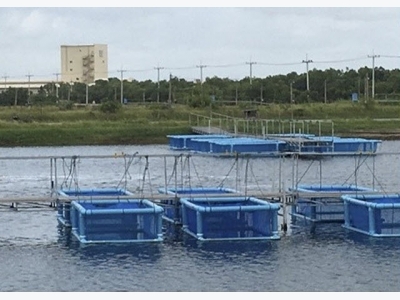Prawn potential: Ridley feed trial in Thailand successful

Ridley’s Novacq feed improves productivity and biomass in prawns by 33%, giving producers production power amid disease concerns, says its CEO.
The 50-day trial conducted in Ridley-leased ponds at Sureerath Prawn Farm in Chanthaburi, Thailand saw Vannamei and Monodon prawns across 10 self-contained, suspended cages hand-fed regular feed or feed containing 5% Novacq - a patented product derived from a marine microbial process.
Prawns in both treatment plans were harvested, tested and directly compared on growth rate, survival, total food fed, feed conversion ratio (FCR) and total biomass gain.
Results showed that prawns fed the Novacq diet reached harvest weight 20 days ahead of Thailand’s typical 70-day cycle.
Ridley Corporation said such an improvement was “highly significant” for farmers, enabling an increase in production cycles per annum from three to four, which equated to a 33% combined improvement in biomass and productivity.
Tim Hart, CEO of Ridley Corporation, said the possibility of introducing additional production cycles held strong appeal
“This is a farm by farm decision, but I would think another cycle would prove very economic and profitable for farms,” he told FeedNavigator.
Faster harvesting, disease mitigation
Ridley Corporation said Thai prawn producers typically followed three 70-day production cycles each year, but the possibility of quicker harvest times and extra cycles resonated with producers struggling to mitigate disease risk.
“Thai prawn farmers have […] suffered in recent years from loss of biomass through disease, such as Early Mortality Syndrome (EMS), and rather than grow bigger prawns, the preference is likely to be to harvest early, de-risk the business, and generate much earlier cash returns for reinvestment,” the company said.
Hart said there could be a similar appeal among Australian prawn producers – introducing a second production cycle to their typical one harvest per annum –although they could also simply prioritize growing bigger prawns, faster.
“While the Thais may prefer a strategy of harvesting early, mitigating their production risk and introducing a fourth production cycle, Australian prawn farmers may be equally interested in the extrapolation of the trial period based on usual prawn lifecycle growth trajectories.
“The extrapolations suggest there could be a 25% biomass improvement after 70 days and 27% after 80 days, and Australian consumers have traditionally been willing to pay a premium for large prawns.”
Scaling up faster – July 2018 the goal
The focus for Ridley now, the CEO said, was to commercialize the product quickly and with these Thailand trial results that would now be possible by July 2018 – one year ahead of the initial five-year schedule.
Hart had previously told FeedNavigator Novacq would not be commercialized for another 18 months.
“We now have a scalable production process, have proved the efficacy, and the final step is to finalize our commercialization plan.”
“…These results ratify our confidence in pushing ahead with our Novacq applied R&D strategy towards commercialization here in Australia and also overseas, commencing in Thailand and then expanding through export sales to its neighbors in the region.”
Asked if Ridley would stick to the 5% inclusion rate tested in Thailand, he said: “We have tested a number of inclusion rates including up to 10% and our lab trials have highlighted that 5% is the appropriate inclusion to balance on-farm productivity and economics.”
The company, he said, would also look at developing blends for producers in the long run. “Blends are very much a part of our strategy and the composition of other synergistic ingredients with Novacq are being assessed.”
Trial details
Ridley personnel managed the trial in Thailand. It followed strict protocols with water quality tested twice daily including temperature, salinity, pH and dissolved oxygen.
All feed was administered by hand to each cage and Ridley said both diets proved to be highly water stable with no signs of dissolution up to four hours post-immersion.
Throughout the trial, two size classes were tested – a started feed for the first 21 days, followed by a larger pellet for the remainder of the trial.
Related news
 What makes feed more appealing for farm-raised shrimp?
What makes feed more appealing for farm-raised shrimp? Krill meal and scents additives can boost feed intake of farm-raised shrimp and may improve growth, find US researchers.
 Can fermented soybean meal replace fishmeal in shrimp feed?
Can fermented soybean meal replace fishmeal in shrimp feed? Fermented soybean meal may offer partial fishmeal replacement for farmed shrimp and support growth, production.
 Torula yeast can replace up to 60% of fish meal in shrimp diets: study
Torula yeast can replace up to 60% of fish meal in shrimp diets: study Torula yeast may support farmed shrimp growth and survival when replacing portions of fishmeal in the diet, say researchers.